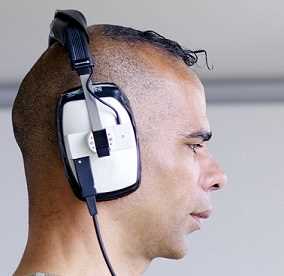- Our Students
- Alumni
- 2017
- Wayne Binitie
Techne
Wayne Binitie profile
Thesis
Aesthetics of Water - Re-calibrating the perception of glacial water through audio-visual contemporary art practice
About
This practice-based research investigates the urgent and ethical stewardship of glacial water at a time of accelerating climate change. What are the environmental risks posed by the rapid disappearance of glacial water? How can the potency of glacial water be revealed through a contemporary art practice? How can a contemporary art practice reveal and communicate the urgency of climate change to new audiences?
This research seeks to interrogate these questions and posits that advances made within digital and industrial technologies offer timely and renewed scope for increased glacial water sustainability, ethical stewardship and cultural awareness. Anchored by my own audio-visual fieldwork at the British Antarctic Survey ice core archive, the research aims to rethink the use of digital and industrial technologies at the pioneering Arup SoundLab in order to artistically reveal and culturally communicate the significant role of glacial water within the wider global climate change challenge.
Ranging across 800, 000 years of geological time, the BAS ice core archive contains important archival information from the glacial past including temperature and concentration of atmospheric gases. Ice cores are cylinders drilled from an ice sheet or glacier that are traditionally used by scientists to measure and predict the direct correlation between the climatic atmosphere, rapid global warming and rising sea levels. Crucially, ice cores contain small bubbles of compressed air from the ancient past that make popping sounds when dissolved in water.
I have been conducting audio and film recordings of these compressed air bubbles. Ensuing initial research at the RCA has involved refining methods for vibrating glass powders and volcanic ash using my recordings from the BAS archive. The resultant cymatic patterns have then been furnace cast on metal plates with hot glass, then cut, polished and sculpted into solid forms and surfaces as permanent indexical traces of the climatic past.
Imagine if you could hear, see and feel the climatic atmosphere of the glacial past? This is what the Arup state-ofthe-art SoundLab does for the audio field recordings conducted at the BAS. It allows audiences to experience firsthand the conventionally inaudible and invisible glacial histories contained within the ice core archive while providing the industrial technologies needed to develop new methods to closely analyse and digitally re-archive glacial information from the fragile, ephemeral and rapidly disappearing Antarctic landscape.
My research aims to bring the scientific archive alive. Re-calibrating audio-visual field recordings at the Arup SoundLab through an expanded use of spatialisation techniques, audiences will be invited to participate in a fully immersive, multi-sensory contemporary art practice where they will be able to experience bodily the BAS ice core archive. In counterpoint to tools and methods traditionally used by ice core scientists, the technique of spatialisation involves the digital reconfiguring of imperceptible data streams within a specific listening and viewing environment. In this context, the Arup SoundLab situates the transformative potential for the research to test, modify and develop innovative audio-visual contemporary artworks that reveal and communicate the potency of glacial water in general and ice cores in particular to a wide range of new audiences through large-scale public exhibitions.
My research to date has been informed by a historical literature review of water as an aesthetic subject and medium, which has revealed the singular dominance of the eye within landscape and environmental art theory and practice. In direct contrast to the singular visual sense modality, my research to date has revealed the potential of multi-sensory audio-visual experience and demonstrated the exhibition format as an important evaluative tool and method to situate contemporary audience engagement with the complexities of climate change.
At a time of rising sea levels and rapid melting of glaciers, this practice-based research questions the broader, ethical and societal urgency of global climate change in order to articulate how a multi-sensory and artistic approach to glacial water generates an increased awareness of the glacial past, present and future. The research makes an original contribution to audio-visual knowledges of the BAS ice core archive through an expanded use of industrial and digital technologies.
